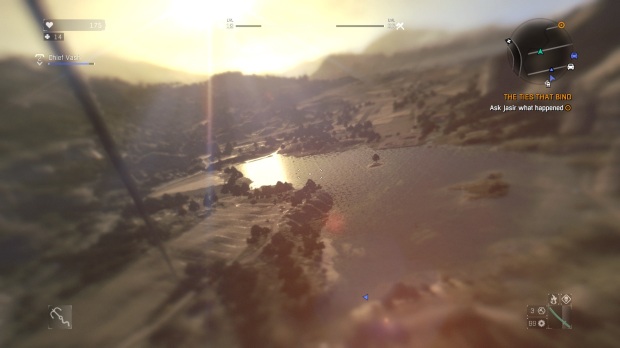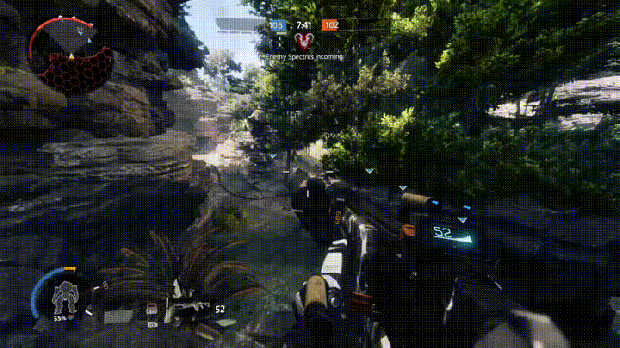Movement Mechanics – The First Building Block of Gaming
Videogames are their own Contained Universes
Games are a plethora of many different things. They encompass so many diverse elements that analyzing them can become as complex as analyzing anything in the natural world. Unlike the mystic creations of mother nature however, video games are man-made, crafted experiences. But just like the innate laws of physics found within this particular universe, each game has a set of principles that dictates how that world exists. In many ways, videogames are microcosmic mimicry of our own universe.
Through clever abstract controls and contextual input, games like Grand Theft Auto V allow players to adequately represent a great deal of actual human behaviors.
In many ways, GTAV is a very thorough depiction of a mini-universe. Stopping to ponder the multiple complex systems, mechanics, social interaction, narrative design, driving, running, skydiving, mini-games, user-generated content, physics, and so many other facets I didn’t list can make the head spin for an educated gamer, much less someone unfamiliar with modern games.
Now while we hopeful homies may enjoy making your head spin, this article is going to strip all of those complex systems away in favor of digging deeply into just one: movement mechanics.
The Importance of Movement
At their most fundamental level, videogames are in many ways simply about movement. Navigation through a front-end or menu UI is movement. A solitary input for jumping in “Fun Run” is movement. Point and click adventures are movement. Card selection is movement. Moving your digital avatar, your cursor, or your gigantic mechanized behemoth in a virtual landscape is one of the most basic building blocks to a game. If the movement in a virtual space is fun, then it’s simply a joy to exist in the world itself.
The smoothness and responsivity is integral to the experience feeling joyful and autonomous. The difference between fluid responsivity when playing a game of Pong versus a half-second of input lag is the difference between a functioning game and a frustrating one. Without any user input, the videogame loses its most fundamental element: the interaction.
Taking a quick jaunt through the complex history of gaming reveals a progression in complexity of movement mechanics: moving from 2D single input games to 2D side-scrollers to 3D 3rd person to games that fully mimic the general abilities of human beings to walk, crouch, jump, aim, and shoot.
How Controller Input Represents Movement
Tom’s Take: I would add here that recent modern games attempt to fully mimic the general abilities of human beings. With good design, the mimicry can get shockingly close to perfect, and the closer a game’s movement mechanics are to real life, the more immersive the experience can be; to e-vaughn’s point, this is when simply existing in the world can be a joy. Of course, with bad design, there are frequent frustrations when a character is too slow to jump over a hurdle of some type, or when there are glaring inconsistencies in a character’s traversal ability in order to keep the player ‘on the rails’ of the game.
What I find particularly interesting is actually the most modern, emergent, and future tech in games. Of course, virtual and augmented reality have been ideas for a while, but they are reemerging in exciting new ways of late. Movement in these environments can still be rudimentary and simplistic, but the brain has an incredible way of filling in the cognitive gaps to make the experience feel even more real. The addition of a ‘preview’ feature to the sight-line teleportation on the Vive could be terribly disorienting, but also incredibly useful (check the video below, you can get a good sense of it around 3:37)
Then you have the variety of startups who attempt to make VR-enabled treadmill contraptions so that players can actually move while in-game. There has been some backlash though – of course – and some of it is pretty founded (click through for Mashable’s article entitled “VR Startups: Stop trying to make virtual reality treadmills a thing”). Afterall, it would be incredibly hard to conceptualize a comfortable way to enable crouching, jumping, diving, sliding, etc. on such a contraption, not to mention that the majority of designs are relatively non-inclusive and may only be good for certain types of games.
The Importance of Nailing Movement
The act of movement in itself often supersedes that of gaming rules, goals, or narrative. Since the movement is effectively input and controlled over the virtual space, it’s easy to understand how pivotal it is. It’s also of the opinion of these homies that it is also one of the most important elements to simply enjoying the time spent in the virtual world.
It’s not uncommon to hear gamers beefing about an inability to jump or feeling like one’s character is moving through quicksand. These comments should garner a high priority in development because any tenable goal is met through these mechanics.
In the formative years of FPS console games, Halo: Combat Evolved managed to nail the basics of thumbstick aiming. Failing this which could have flatlined the game, the franchise itself, and perhaps twin-stick shooters of the future. A decade plus later and twin-stick design is so commonplace, it’s almost taken for granted how difficult that controller input was once to learn.
These days, more and more games, like Dying Light and Dishonored, are knocking traversal mechanics out of the park. Other games, like the Witcher 3, have so much incredible content and surrounding richness that their relative clumsiness in movement can be overlooked.
The Hopeful Homies Highlights for Traversal Mechanics
There are a few games that have crafted some incredible mechanics for movement and invigorated their game with such fluid and autonomous movement that it’s simply a joy to exist in their respective virtual worlds.
Dying Light
Tom and e-vaughn rocked through the cooperative campaign together, and we were both stunned at how fluid and nuanced the parkour system in this zombie-focused FPS RPG was. Climbing pipes and towers, traversing wide open spaces, and vaulting is not an easy task to mimic in 1st person. Dying Light nails it.
Tom’s Take: Not only does Dying Light nail the basics of movement, but it gets most of the details right as well. For instance, while the zombie fighting, beheading, and drop-kicking was exhilarating, sometimes walking across a skinny-ass pipe was just as breathtaking and heart-pounding while in the campaign. I’m not sure how many times e-vaughn heard me yell at my Xbox to ‘Record that!’ but I have a treasure trove of traversal tricks.
Youtuber RinguPingu shows off a jump between cranes in Dying Light. When the surfaces get even narrower, the character’s view even seems to sway slightly, and I found myself leaning into it more than a few times.
Some of my favorite moments from the game are the successes and failures of traversal and movement in the world. As you progress through the campaign, you are rewarded for essentially everything you do – which is, well, damn rewarding. But this helps you try harder to attempt new tricks in movement, run along the skinny pipes, climb the taller towers, and vault right over zombie heads. Some other specific aspects that make movement in Dying Light awesome include:
- The fact that XP progression bonuses reward the player for experimenting with awesome traversal and fighting tricks. This means that any successful traversal nets tangible experience for your character. it’s a feedback system that is transparent and provides clear prompts letting you know “you’re doing something productive”, making simply existing and exploring a worthwhile endeavor.
- Jumping is done with RB on the Xbone rather than a face button, so both thumbs can be on sticks at all times during dynamic movement.
- Side quests are frequent and sometimes include small challenges between the co-op campaigners where the players have to race across some crazy distance, getting points all the way across the map.
- New movement mechanics are introduced regularly and impact the game pretty dramatically. Of course the usual slides and extra jumps and weapon mechanics are upgraded, but the game also introduces a grappling hook, which dramatically alters the possibilities for the character.
- A good old-fashioned zip-line is also a great opportunity to enjoy the scenery

Zip-lining through Dying Light’s world is common, and a great opportunity to also appreciate the crazy amazing draw distance and detail
Titanfall 1 & 2
Titanfall holds a special place in the world of FPS for many reasons. Capitalizing on movement focused gameplay like wall-running, grappling hooks, double-jumping, slide-hopping, bunny-hopping, and comboing each and every one of these mechanics, the game holds many keys for expressing one’s desire to traverse. While unfortunately demanding a relatively high level for FPS skill to enter, utilizing each one of these mechanics rewards players with abundant “wow” moments in-game.
It creates a sense of flow, style, and gunplay generally not seen in the FPS realm. It essentially plays out like Tony Hawk’s Pro Gunfighter, and learning to string together the mechanics to traverse the world quickly and autonomously never feels old. Even crossing a simple field or meadow becomes an exercise in precise movement as players can practice their slide-hopping or try and find some physical object to increase speed or bound nimbly through the air.

The mechanics are so tight and responsive that I’ve struggled to re-enter games that have slower movement, and I dare say that Titanfall 2 might have the greatest feel to FPS gameplay I’ve ever had the privilege of enjoying.
Halo 5
Never being one to stagnate on mechanics, each title in the Halo franchise has adapted and changed some element of its core gameplay.
- Halo CE solidified the twin-stick shooting, the golden triangle of grenade/shoot/melee each being an autonomous and quickly accessible button, and infused vehicle combat naturally into the sandbox.
- Halo 2 introduced dual-wielding and became synonymous with a high-skill ceiling due to the button glitches that allowed PVP to flourish.
- Halo 3 brought in equipment that created gravity lifts, bubble shields, and more into the sandbox.
- Halo 4 made sprint a permanent ability, allowing players more autonomy in their traversal.
- Halo 5 doubled-down on their traversal expansion and made player movement an even larger function, while still maintaining the jousting element of gameplay the golden triangle afforded players. Now, users could clamber, hover when aiming, thrust to avoid fire in any direction, ground-pound from a high altitude, and of course could sprint and slide. Combined with Halo’s classically high Time To Kill and an even further reduced aim assist, the game took skill-based combat to a new level. Any given 1 on 1 battle means that a skilled player can effectively use all of the skills in this sandbox to their advantage and create an even higher ceiling for skill-based gameplay.
With FPSs so heavily relying on the concept of positioning, these traversal mechanics aim to give more and more freedom to players in order to place themselves exactly where they want.
Ori and the Blind Forest
Tom’s Take: Ori and the Blind Forest is a gorgeous Metroidvania 2015 release by Moon Studios and Microsoft Studios. There is the standard skill tree that determines what movements and powers the adorable protagonist possesses, and the progression through the tree is set by the player’s ability to explore and navigate the world. Beyond the skill tree though, the movement matches the environment and is extremely fluid and natural feeling.
Most of Ori’s world is what most would think of as an enchanted forest, for good and evil. Traversal through this world involves timing jumps perfectly to dodge enemies while balancing delicately across tree stumps surrounded by a damaging poison. Another sequence that sticks out in my mind is when the player must use a grapple-type power called ‘bash’ to swing across a great expanse from vine to vine, avoiding a punishing death laser at every transfer.
As the skills of the character advance, I found myself doing less waiting, calculating, and finally trying, and more flow-state completion of entire rooms in one attempt. Granted, that one attempt was usually preceded by multiple deaths. The ‘bash’ move is learned relatively late in the skill tree, but provides the type of world-altering power as the grapple did in Dying Light. Suddenly, rooms and spaces can be maneuvered through without ever touching the ground.
Speaking of not touching the ground, the cute little guy also gains the ability to float via leaf through his environments, occasionally utilizing an updraft to soar straight up before effortlessly floating back down. I loved this mechanic, and it fit into the overall feel of the game really well.

“I am a leaf on the wind” Okay, that’s not from Ori, but it feels majestic floating through the gorgeous but sometimes torched-earth landscape
Ori also did a fantastic job of keeping the direction of play fresh. Although the view and movement is constrained by two dimensions, the creativity of some of the toughest sequences in the game involved racing straight upwards through a variety of tubes, pipes, and pinball-like contraptions to escape a great flow of water filling up the hollow insides of a magical tree. Ori is beautiful, super fun, and frustrating as hell in the best of ways at times.
Sunset Overdrive
This game is most easily described as an extreme action sports game like SSX Tricky or Aggressive Inline mixed with Platforming third person splatterific gameplay like Conker’s Bad Fur Day or Splatoon. It’s bright, vulgar, aware of itself, and tons and tons of fun. What makes it so awesome is that it’s actually a joy to move from A to B on the map.
Starting out gameplay, you learn to grind, swing on streetlights, wall run, and bounce on terrain to get around the environment. Doing this makes you a hard target, makes it easier for you to tackle combat of the squishy mutant creatures, and you feel so good doing it. The addition of a style meter as you perform these feats helps to provide feedback about how well your movements are combined, and hitting specific level in the meter amps up your experience progression. It’s an awesome feeling.
Like any flow-focused experience, it takes time to figure out what elements in the environment allow you to generate more speed and string traversal mechanics together, but once you do, oh man you feel unstoppable. As you play you end up getting more and more unlocks for movement options (not to mention tons of guns) and it makes getting to new places even more fun.
It’s a testament to the impressive movement system that some of the most fun of the game are the traversal challenge side-quests. Once again, this is the type of game that simple makes moving through the environment learning new tricks and style combos an absolute joy just to exist in.
More Movement, Please
With all these incredible titles and great movement mechanics, our advocacy is pretty clear. Increase autonomy with more robust and expansive movement systems, craft movements that are learnable but still with a high ceiling for obtaining mastery, and identify that nailing the “feel” of movement may be one of the most pivotal elements of your game.
Gameplay Design Worth Advocating For:
- We love movement mechanics that allow us to expand beyond our own limited movements in the real world. They feel so incredible to pull off and having a nuanced system that allows a player to express their movement needs on a world while getting clear feedback that they’re dope as hell is a great feeling.
- We love that complex movement mechanics increase the skill ceiling of any game while also making the virtual environment less of an obstacle and more of a playground. Sunset Overdrive and Titanfall especially exemplify this. The world is one giant playground because of these movement mechanics, and they bring in so much function.
- We love that by incorporating fun and skill-based movement, one can take the act of walking across a boring plain and making it an active, engaging experience. Slide-hopping your way across a meadow in Titanfall 2 is actual practice for PVP matches, and also an active way to get players to excel beyond simply holding up on the movement thumbstick.
- We love that the certain games give direct feedback that just by doing something in the game world, you’re improving your character. We’re looking at you, Dying Light, and the fact that you tell me exactly that I am boosting my parkour skills by doing more parkour. This reflection of the practice of real life is nice to see in videogames too.
- We love that including more complex movement mechanics (air strafing and bunny-hopping) raises the skill ceiling but still allows newer players to play as they like. You can beat the game without using those, but there’s always more room for gaining mastery!
- We love that traversal mechanics are always improving and allow us as humans to express our autonomy and control beyond what our bodies are actually capable of. It’s not exactly the same, but there is a huge tangible feeling of accomplishment nailing huge combos in any Tony Hawk game. Same thing applies to Titanfall here. In fact, adding a trick meter or combo meter to these games might make existing in that environment even more fun than it already is! Respawn entertainment, ya hear that?
e-vaughn & Tom

Pingback: Why do Sequels Drop Design Mechanics? -Comparing Titanfall 2 vs. Titanfall 1 | Hopeful Homies
Reblogged this on The Gamer's Binge.
LikeLike